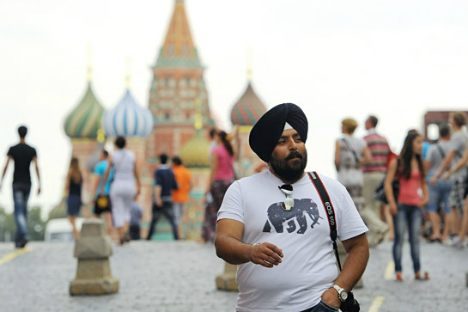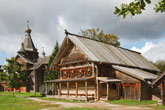Gateway to the White Sea
Photos by William Brumfield
Kem, a regional town in the Republic of Karelia, is known to most visitors as a major route to the Solovetsky Archipelago and its great Monastery of the Transfiguration. Yet the town has a dramatic history of its own, which, like that of the Solovetsky islands, combines elements of the spiritual with human tragedy.
The very setting of Kem is dramatic, with a rocky coastline bounded by dense forest that reaches the west shore of the White Sea. The historic town is located primarily on an island known as Lepostrov, which is flanked by the arms of the small Kem River near its confluence with the sea.
During the medieval period, these northern lands were tenuously held by the commercial power of Novgorod. In 1450, Novgorod granted the settlement at the mouth of the Kem River to the Solovetsky Transfiguration Monastery, which had been formally established in 1436 on a group of islands in the southwestern White Sea.
Through this grant, the Solovetsky Monastery acquired a land base and port about 40 miles to the west of its archipelago.
How to get there
To get to Kem take one of regular trains from Moscow (Leningradsky or Kursky railway station) following to Murmansk and get off in Kem.
Because of its strategic location, Kem gained the unwanted attentions of hostile neighbors in the late 16th century. Tsar Ivan IV (the Terrible) was at that time mired in a protracted conflict known as the Livonian War (1558-1583), which in its latter phase involved a struggle with Sweden for control of the Eastern Baltic region.
In 1589, Kem was raided by Finnic forces, and in 1590 the region was attacked by the Swedes. The following year Moscow reaffirmed the Solovetsky Monastery’s title to the Kem territory.
The power of the monastery allowed it to function as a surrogate for Muscovy, and during the next century Kem was defended and fortified under the monastery’s direction.
Kem was briefly returned to state control from 1704 to 1711 during the early phase of Peter the Great’s struggle with Sweden known as the Great Northern War (1700-21).
With Peter’s victory over King Charles XII at Poltava (July 1709), pressure on Russia’s White Sea territory diminished. To symbolize Russian power in the area, the Cathedral of the Dormition was erected in Kem in 1711-1714.
That this extraordinary log structure should be designated a cathedral is indicative of the distinctive culture of northern Russia. Its three tent towers, which signify the presence of three altars, soar above an elevated location.
Despite wooden scaffolding from an ongoing restoration, the west (front) facade of the cathedral is largely visible. A decorated porch leads to a wide one-story structure with low-pitched roofs.
The ascending levels of the three roofs provide a harmonious pedestal for the central tower, which rises from a square base to an octagon that supports an eight-sided "tent" tower. Some 120 feet high, the tower is crowned with a wooden cupola and cross. It is flanked by two smaller towers over chapels attached to the north and south of the main structure.
The church interior begins with a spacious vestibule (or refectory), whose trimmed log walls are lined with benches. In the center are massive painted log columns that support key elements of the roof.
A portal leads from the vestibule to the main worship space, whose icon screen on the east wall has been partly preserved and is being restored. Behind the screen is the primary altar, dedicated to the dormition of the virgin.
The octagonal upper space culminates in a ceiling of planks arranged in a chevron pattern. The west wall supports a small wooden choir gallery. To the right of the main space is a chapel dedicated to St. Nicholas.
To the left is the north chapel, with an altar dedicated to Sts. Zosima and Savvaty, founders of the Solovetsky Monastery. The north chapel has a separate entrance from the outside. More easily heated than the main space, this chapel can be used for winter worship.
The territory of the Dormition Cathedral also has a separate chapel built around 1710 and dedicated to the Trinity. Square in shape, the interior of this small structure contains a remarkable carved votive cross associated with Peter the Great.
Kem remained under the control of Solovetsky Monastery until 1764, when Catherine the Great initiated reforms that curtailed monastic holdings. At that point, the town became a part of various administrative divisions in the White Sea area.
During the 19th century the town survived primarily on the basis of fishing; the rocky soil could only support subsistence farming for its some 2,000 inhabitants. In 1903, Kem gained a large masonry church, the Cathedral of the Annunciation.
Severely damaged during the Soviet era, the church is now being restored as part of the recently established Monastery of the New Russian Martyrs and Confessors.
Kem's growth was stimulated during World War I with the construction in 1915-1917 of a strategic railroad through the town to the new port of Murmansk. Following the Bolshevik revolution, Kem was occupied in 1918 and 1919 by White troops and briefly by an Anglo-American force.
With the return of Soviet power, Kem rapidly became a part of the system of supply and administration for a penal camp established by the Soviet political police in 1919 on the territory of the former Solovetsky Monastery.
In 1921 this prison was named the Solovetsky Camp of Special Designation and it was described by Alexander Solzhenitsyn in the Gulag Archipelago. The camp was closed in 1939. A large wooden votive cross now stands on a rocky elevation near the harbor to commemorate the fate of those who embarked from Kem to this sinister destination.
During World War II, Kem served as an important station on the critical rail route for allied Lend-Lease deliveries through the port of Murmansk. Although much of southwestern Karelia was occupied by Finnish forces until the summer of 1944, the railway continued to function via a link around the south shore of the White Sea to the Arkhangelsk-Vologda line
Today, after years of declining numbers, the population of Kem has stabilized around 12,000. Easily accessible on the major rail line from the Karelian capital of Petrozavodsk, the town is sustained in part by the revived Solovetsky Monastery, which attracts an increasing number of visitors.
All rights reserved by Rossiyskaya Gazeta.
Subscribe
to our newsletter!
Get the week's best stories straight to your inbox



